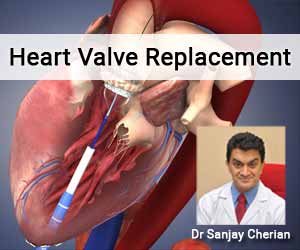- Home
- Editorial
- News
- Practice Guidelines
- Anesthesiology Guidelines
- Cancer Guidelines
- Cardiac Sciences Guidelines
- Critical Care Guidelines
- Dentistry Guidelines
- Dermatology Guidelines
- Diabetes and Endo Guidelines
- Diagnostics Guidelines
- ENT Guidelines
- Featured Practice Guidelines
- Gastroenterology Guidelines
- Geriatrics Guidelines
- Medicine Guidelines
- Nephrology Guidelines
- Neurosciences Guidelines
- Obs and Gynae Guidelines
- Ophthalmology Guidelines
- Orthopaedics Guidelines
- Paediatrics Guidelines
- Psychiatry Guidelines
- Pulmonology Guidelines
- Radiology Guidelines
- Surgery Guidelines
- Urology Guidelines
Latest R&D and Technological Developments in Heart Valve Replacement

There are four cardiac valves, namely, Aortic, Mitral, Tricuspid and Pulmonary valves which regulate the flow of blood within the heart. Rheumatic Heart Disease remains the most common cause of valvular dysfunction in developing countries, while degenerative valve disease is more commonly seen in Western countries. Although the initial treatment option consisted of valve replacement surgeries, by which the diseased cardiac valve is excised and replaced with a new prosthetic valve (it could be a mechanical valve or a tissue valve). The recent trend is to try and repair the valve, using several surgical techniques (neochordae implantation, Annuloplasty ring, etc).
MINIMAL INVASIVE SURGERY
The standard operating approach is either through a long incision in the center of the chest (mid line sternotomy) or an incision on the side of the chest, in between the ribs (Thoracotomy). Advances in techniques and technology have permitted valve repairs and replacements to be undertaken through small incisions (mini-sternotomy and mini-thoracotomy). With the advent of minimally invasive cardiac surgeries, there have been several modifications in the surgical instruments whereby smaller incisions and longer instruments are used to correct the valve defect. This allows quicker healing of the wound, less pain, faster recovery and quicker discharge from the hospital when compared to the functional incision.
ROBOTIC SURGERY
Further advancements in minimally invasive techniques have led to the development of Robotic valve replacement and repair wherein, small endoscopic instruments are inserted through 5-6 small incisions. The standard sternotomy is approximately 10-12 inches in length, in contrast, Robotic surgery can be undertaken through incisions of 2 inches each. The surgeon controls the movement of endoscopic instruments in the heart while he sits at a console and watches the anatomy of the heart valve on the high definition screen and moves his fingers on high fidelity controls, which in turn move the robotic hand and instruments inside the chest. The immediate and midterm outcomes of this minimally invasive and robotic procedure have shown to be as effective as the standard incisions. However, the cost constraints are significant and not all surgical procedures are amenable to robotic surgery.
TRANS-CATHETER AND HYBRID PROCEDURES
Another recent advancement is the use of Trans-Cathether Aortic Valve Implantation (TAVI), whereby the aortic valve is implanted in the heart using a long specialized catheter that is passed through a small incision in the upper thigh (femoral approach), under fluoroscopic and echocardiographic guidance. A similar procedure is used to replace the pulmonary valve.
Yet another recent advancement is the use of the Mitraclip, which is the minimally invasive procedure whereby the leak in the mitral valve is repaired using a special stapler device. The longterm results of this valve are yet to be proved and furthermore, the cost implications of the TAVI and Mitraclip are high. Hence, the number of centers that are employing these modern techniques in India is low but is slowly on the rise.
In either cases, irrespective of the advances in science, proper clinical evaluation, early diagnosis, and treatment, remain the key to provide effective treatment to heart patients.
Dr Sanjay Cherian, MS, PhD, Vice President & COO, Department of Cardiac Surgery, Frontier Lifeline Hospital.

Disclaimer: This site is primarily intended for healthcare professionals. Any content/information on this website does not replace the advice of medical and/or health professionals and should not be construed as medical/diagnostic advice/endorsement or prescription. Use of this site is subject to our terms of use, privacy policy, advertisement policy. © 2020 Minerva Medical Treatment Pvt Ltd